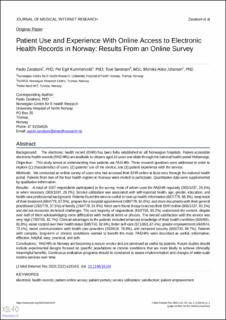| dc.description.abstract | Background: The electronic health record (EHR) has been fully established in all Norwegian hospitals. Patient-accessible electronic health records (PAEHRs) are available to citizens aged 16 years and older through the national health portal Helsenorge. Objective: This study aimed at understanding how patients use PAEHRs. Three research questions were addressed in order to explore (1) characteristics of users, (2) patients’ use of the service, and (3) patient experience with the service. Methods: We conducted an online survey of users who had accessed their EHR online at least once through the national health portal. Patients from two of the four health regions in Norway were invited to participate. Quantitative data were supplemented by qualitative information. Results: A total of 1037 respondents participated in the survey, most of whom used the PAEHR regularly (305/1037, 29.4%) or when necessary (303/1037, 29.2%). Service utilization was associated with self-reported health, age, gender, education, and health care professional background. Patients found the service useful to look up health information (687/778, 88.3%), keep track of their treatment (684/778, 87.9%), prepare for a hospital appointment (498/778, 64.0%), and share documents with their general practitioner (292/778, 37.5%) or family (194/778, 24.9%). Most users found it easy to access their EHR online (965/1037, 93.1%) and did not encounter technical challenges. The vast majority of respondents (643/755, 85.2%) understood the content, despite over half of them acknowledging some difficulties with medical terms or phrases. The overall satisfaction with the service was very high (700/755, 92.7%). Clinical advantages to the patients included enhanced knowledge of their health condition (565/691, 81.8%), easier control over their health status (685/740, 92.6%), better self-care (571/653, 87.4%), greater empowerment (493/674, 73.1%), easier communication with health care providers (493/618, 79.8%), and increased security (655/730, 89.7%). Patients with complex, long-term or chronic conditions seemed to benefit the most. PAEHRs were described as useful, informative, effective, helpful, easy, practical, and safe. Conclusions: PAEHRs in Norway are becoming a mature service and are perceived as useful by patients. Future studies should include experimental designs focused on specific populations or chronic conditions that are more likely to achieve clinically meaningful benefits. Continuous evaluation programs should be conducted to assess implementation and changes of wide-scale routine services over time. | en_US |

